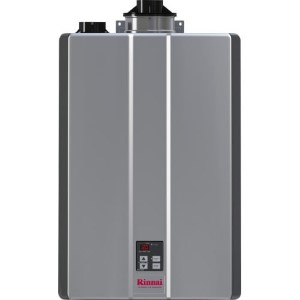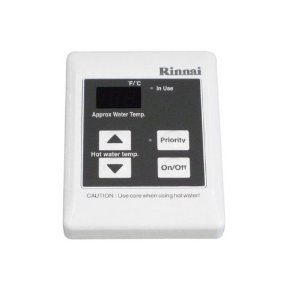How To Use Rinnai
Tankless Water Heater
What you should know when using a Rinnai water heater. How to operate the unit safely, change the temperature and properly use the temperature controller for monitoring?
Advanced technology
After your water heater has been professionally installed, now is the time to learn how to use Rinnai properly for reliable, long time and safe heating.
Rinnai tankless heaters are smart; they use a small computer so they can supply hot water as long as it is needed, on-demand and in continuous supply, and at a preset temperature. To keep the temperature of the outgoing hot water constant, Rinnai adjusts the water flow since the incoming water temperature changes from summer to winter. Thanks to the modulating gas valve, the heater increases or decreases its power during the heating process and is based on the demand and set temperature.
 Rinnai
RinnaiIgnition
Tankless units are equipped with direct electronic ignition, so no need to manually light the fire (there is no pilot light); the unit automatically lights the burner. The gas burns as long as there is a demand for hot water or when the tap is open.
Venting
These units use direct venting, which means they get the combustion air from outside and move the flue gases to the outside.
Manual gas valve
A manual gas valve located close to the water heater needs to be turned counterclockwise to the full ON position. It was assumed that the valve was OFF.
Isolation valves
Isolation valves included with the water heater should be installed on both cold and hot water lines to isolate the unit and do the service or maintenance, such as flushing.
Water flow
Open a hot water tap with the water flow higher than the minimum required (0.4 GPM) and wait some time so it can reach the fixture. How fast you will get hot water depends on the pipe length between the water heater and the tap. It is also mandatory to have a water pressure of 50 PSI minimum (maximum is 150 PSI), while the recommended is 60-80 PSI.
Using the temperature controller to set the temperature

Most indoor water heaters from Rinnai have the temperature controller MC-91-2 integrated into the front of the unit, while it is provided with the outdoor models. Series V53 does not come with the controller.
The controller allows you conveniently to check and control the temperature of hot water, and if something is wrong with the unit, its diagnostic system will show the problem by using the error code.
Use the ON/OFF button to turn ON the electric power to the unit. Set the thermostat to the desired setting. Indoor water heaters are equipped with a control panel consisting of an LCD display and several buttons. You can turn the unit ON or OFF, increase and decrease the temperature (in F and C). When you press the "Priority button," the green light will glow, indicating that the controller controls the temperature and that a water heater is ready.
Rinnai water heaters work in the temperature range from 98 F to 140 F, while they come with the factory setting of approximately 120-125 F.
There is also a temperature controller MCC-91-2, used mainly in commercial applications, for getting higher temperatures, where the maximum temperature is 185 F. A maximum of four controllers can be installed.
Controller and diagnostic codes
The most advanced Rinnai tankless water heaters can diagnose the problem inside the unit and display the error code on the LCD screen.
Diagnostic codes are shown as 03, 10, 11, 14... and every code means a problem, such as no flame, faulty sensors, vent blockage...
Also, the controller can get you some interesting info, such as the water flow rate or temperature of the outgoing water.
Choosing the right temperature
A temperature above 125 F can cause injuries, so special care should be taken when kids and seniors use hot water. For example, it takes only 3 seconds of hot water exposure at 140 F for the first-degree burns. A minimum flow rate is essential for the heater to operate; otherwise, the unit won't run or will produce hot water with the fluctuating temperature.
You can also set and change the temperature without a temperature controller. Still, the default temperature is 120 F, and by adjusting the dip switch, it can be changed up to 140 F.
If there is a power outage during the freezing days, make sure to disconnect the unit and drain all the water. As long as your water heater is getting electric power, the unit will not freeze.
Related
- Find a local Plumber for your Rinnai and get FREE quotes!
- Rinnai tankless water heaters review
- Rinnai RUR98
- Rinnai RUC98
- Rinnai RL94
- Rinnai RL75
- Rinnai V65
- Rinnai gas boilers
- How to troubleshoot Rinnai error code 10
- Troubleshooting Rinnai error code 11
- Troubleshooting Rinnai error code 12
- Troubleshooting guide
- How to use Rinnai
Leave a Comment

